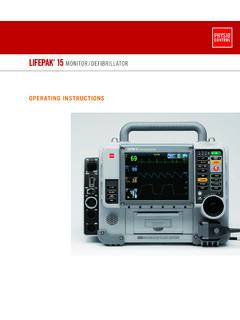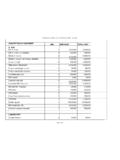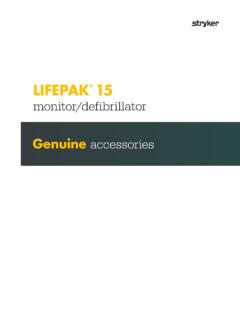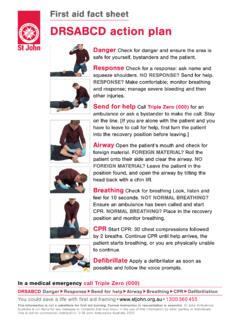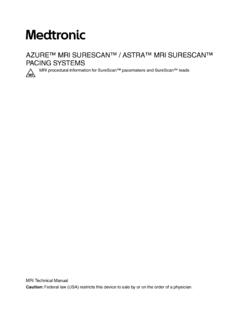Transcription of Nursing Management of Patients with Cardiovascular …
1 Nursing Management of Patients with Cardiovascular Disease Part II: Acute Myocardial Infarction Barbara Moloney DNPc, RN, CCRN Second Patient 52-year-old woman came to the hospital complaining of fatigue, nausea, and chest discomfort Assessment BP 156/80 HR: 100 Rhythm : regular R-28 T-37oC SA2 96% room air Respiratory tachypnea Neurological Anxious, restless, oriented Skin Diaphoretic Complains of Epigastric discomfort 6/10 Nausea Short of breath WHAT ARE YOUR CONCERNS? Is there anything that you want to do now?
2 Focused history Precipitation factor: preparing a meal Quality of pain: pressure in chest and back Radiating no Associated symptoms: Nausea, short of breath, diaphoretic Onset of pain: 6 hours ago Allergies: unknown PMHx: hypertension Meds at home: hydrochlorothiazide ECG Review: Coronary Arteries Supply oxygen to the myocardium Formation of Plaque Coronary Artery Disease Non-modifiable Risk Factors Age Gender Genetics Contributing factors Diabetes Stress Modifiable Risk Factors Smoking Hypertension Hyperlipidemia Physical Inactivity Obesity Blocked Coronary Artery Myocardial ischemia Anaerobic metabolism Lactic acid irritates cardiac nerves Angina Ischemia>20 min.
3 = acute myocardial infarction How it looks on ECG Different leads show different views of the heart What does this look like on the ECG? Blue circles = ischemia, Red circles = injury STEMI: ECG changes = injury through the myocardium Area of necrosis penetrates full myocardium = ST elevation usually followed by Q wave as MI evolves NSTEMI: no permanent ECG changes = injury does not go all the way through the myocardium Small area of necrosis not penetrating full myocardium; may have some non-specific ST-T wave changes, but will not have ST elevation Blood tests Marker Normal level Time for Onset of increase Peak concentration Return to normal CPK (total) 15-105 U/l men 10-80 U/l women 4-6 hours 12-14 hours 2-3 days CK-MB 0-9 U/L 4-6 hours 12-24 hours 2-3 days CK index < Troponins T & I ng/mL (tropI) Check lab 2-4 hours 8-12 5-14 days What happens to the heart?
4 Normal heart beat: Heart during a myocardial infarction Analysis Your analysis Review: Signs and symptoms Pale, diaphoretic Chest discomfort Epigastric Pressure Pain Arm, shoulder, neck, jaw, back Restless, apprehensive Dyspnea, orthopnea Palpitations Syncope confusion Cyanosis Nausea Fatigue Women, Diabetics, Elderly Symptoms may be more vague Fatigue Short of breath Indigestion, nausea Anxiety Silent ischemia Vital signs Temperature elevation Up to 38 o C due to tissue damage within first 24 hours May last for as long as a week Pulse may be rapid, irregular.
5 Or slow Respirations increases with pain and anxiety may increase if in heart failure decreases with sedation Blood pressure may fall below 90 immediately following an MI, returns to pre-infarction 2-4 days Other tests WBC rise in early phase of infarction Sed rate rises in early phase Electrolytes PT/PTT/INR Platelets CBC Chest x-ray Echocardiogram Nursing Diagnoses Problem List Myocardial Ischemia/Injury Pain related to myocardial ischemia Nausea Short of Breath Hemodynamic Stability Risk for dysrhythmias Risk for decreased cardiac output Anxiety Knowledge Deficit Guidelines for Management Assess.
6 Chest pain, Vital signs MONITOR #1 cause of death is dysrhythmias ECG IV access/blood draw Oxygen, medications Chest x-ray American Heart Association Guidelines, 2011 Medications Aspirin Nitroglycerine Oxygen Morphine Aspirin Action: Decrease platelet aggregation Dose 162-325 mg chewed as soon as ACS is suspected Nursing considerations Allergy Nitroglycerine Action: Vasodilates Dilates coronary arteries Increases collateral blood flow Dose: mg SL Give every 5 minutes for a total of 3 doses if needed Nursing considerations Assess pain and blood pressure after each dose Oxygen Rationale: Reduces pain Reduces risk for dysrhythmias Morphine Action: Reduces pre-load, afterload Reduces anxiety, pain, dyspnea, and Reduces myocardial oxygen demand Dose 1-5 mg IV Nursing considerations Monitor for effect, monitor BP, nausea, respiratory depression Heparin Action: Inhibits thrombus Dose Monitor PTT Nursing considerations.
7 Bleeding precautions Monitor PTT Protamine sulfate Clopidogrel (Plavix) Action Inhibits platelet aggregation May be given in place of ASA or in addition to ASA Dose May be given a loading dose (300mg or 600mg) followed by 75mg daily for 3-12 months (maybe longer if client has stents) Nursing considerations Allergy Bleeding Discontinue steroids & avoid NSAIDS Beta Blockers Metoprolol Administered to acute MI usually within 2 hours - may be given IV Action: Slow heart rate Decrease oxygen consumption Decrease pain Nursing considerations Monitor blood pressure, pulse ACE inhibitors (Lisinopril, Quinapril) Decreases ventricular remodeling helps the heart heal Start slowly - usually within first 24 hours Action Reduce afterload Reduce pre-load Decreases ventricular remodeling Nursing considerations Orthostatic hypotension, monitor VS Dose start low Plan: Nursing Care Chest pain.
8 Manage and alleviate Monitor Dysrhythmias ST segment Vital signs, including oxygen saturation Anxiety: assess and reduce Monitor labs esp. potassium and magnesium Continuous assessment lung sounds, heart sounds, head to toe Activity Bed rest if unstable (having chest pain) Once hemodynamically stable should not be in bed longer than 12 hours Monitor response of heart rate remember increased HR = increased oxygen consumption of myocardium Prevent constipation Monitor effects of medications Now What????
9 Your patient is on the monitor Her heart rhythm becomes irregular She becomes unresponsive Now what do you do? 1. Establish unresponsiveness 2. Call for help defibrillator or DEA 3. Check for pulse 4. Start compressions give 30 5. Open airway 6. Deliver 2 breaths with ambu bag 7. Continue CPR until defibrillator arrives Nursing Management : CAB American Heart Association (2011) New Guidelines #p/c/7A68846B17049716/9/O9T25 SMyz3A (3 minutes in English; change to French version when available) Key points: Know what to do if a patient becomes unresponsive Know where the defibrillator or DEA is Code cart needs to be checked regularly, defibrillator must remain plugged in Teaching guidelines Patient teaching Start as soon as patient is ready Diet and Activity Medications Smoking cessation client and family How to take nitroglycerine, when to call the MD or come to the ED Risk factors modifiable Cardiac rehab Guidelines continued Signs and symptoms of acute MI.
10 Angina and the reasons they occur Healing after MI Risk factors Rationales for treatments Resumption of work, physical activity, sexual activity Measures to take to promote recovery ad health Importance of gradual, progressive resumption of activity When to seek and how to seek help Teaching guidelines for HT Explain what HT means may include numeric value Dietary recommendations Life-style recommendations Medications
